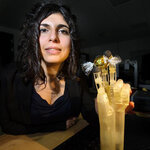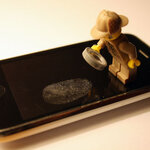Technology

Millions of people injure themselves each year lifting physically demanding things, with (insert absurd number here) of dollars in lost productivity, etc., etc.
Okay, enough of that, here is the fun part: Some day a cute 105 pound nurse may be able to lift your fat keester into a hospital bed after you injure yourself lifting heavy things incorrectly, and you will be able to thank 'soft' robotics.(1) Which is another way of saying that she might be wearing a power vest that gives her super strength.
Well, not all that super. She won't turn into Captain Marvel(2). What the vest will do is…

Cyber warfare, killer robots, biological pandemics due to mad scientists, the Bulletin of the Atomic Scientists has grown since the old days of just figuring out how to kill nuclear power.
You may not know the name of the activism group but you know their most famous creation - The Doomsday Clock. It captured the imagination of the public when it was unveiled in 1947 because we were clearly in the Atomic Age. Once we had a bomb, it was assumed it would be no time at all before some Romanian dame got our secret plans from a gullible physicist. For that reason it was set at 7 minutes before the…

In cultural perception, an artificial hand looks something like a Steampunk reworking of a hand, with gears and pistons and rods. In the future, an artificial hand would look just like a hand, except with muscles made from smart metal wires.
Engineers at Saarland University have equipped an artificial hand with muscles made from
nickel-titanium
shape-memory wire, enabling the fabrication of flexible and lightweight robot hands for industrial applications and novel prosthetic devices. The muscle fibers are composed of bundles of the ultra-fine nickel-titanium alloy wires, each about the…

A team that developed an algorithm capable of automating the analysis of plankton populations – a critical step in measuring ocean health - has won the inaugural National Data Science Bowl.
The winning group discovered a way to effectively organize a data set that would have taken marine biologists more than a century to manually classify in only 90 days of analytics problem-solving. Team Deep Sea from Ghent University developed the most effective algorithm to automatically classify more than 100,000 underwater images of plankton. The work by the seven-person team of graduate…

When checking your email over a secure connection, or making a purchase from an online retailer, have you ever wondered how your private information or credit card data is kept secure?
Our information is kept away from prying eyes thanks to cryptographic algorithms, which scramble the message so no-one else can read it but its intended recipient. But what are these algorithms, how did they come to be widely used, and how secure really are they?
Coded messages
The first cryptographic methods actually go back thousands of years to the time of ancient Greece. Indeed, the word “cryptography” is…

80 percent of patients survive when kidney cancer is detected early - but it is often not easy. However, finding it early has been among the disease's greatest challenges.
Kidney cancer is the seventh most common cancer in men and the 10th most common in women, affecting about 65,000 people each year in the United States. About 14,000 patients die of the disease annually. Like most cancers, kidney tumors are easier to treat when diagnosed early. But symptoms of the disease, such as blood in the urine and abdominal pain, often don't develop until later, making early diagnosis difficult. …

For every parent who ever wondered what the heck their teens were thinking when they posted risky information or pictures on social media, a team scholars suggests that they do not think like most adults do.
In the analysis, the IT authors report that the way teens learn how to manage privacy risk online is much different than how adults approach privacy management. While most adults think first and then ask questions, teens tend to take the risk and then seek help, said Haiyan Jia, post-doctoral scholar at Penn State in information sciences and technology.
They used results from…

Windows 10 build 9926 has been with us for 53 days, or almost two months. While faster releases would be nice for those of us who don't mind bugs, it gives us an idea that Microsoft is going to release something that looks 99.9% like this build in the end. My opinion after looking at this OS and using it as a daily driver on my Surface Pro 3 while teaching and researching is that it is the OS of the future in many ways. In the future we will not interact with our computers by mouse and keyboard. That future is finally becoming technically possible. If other OS's…

Forensics is changing in the digital age, and the legal system is still catching up when it comes to properly employing digital evidence.
Broadly speaking, digital evidence is information found on a wide range of electronic devices that is useful in court because of its probative value. It’s like the digital equivalent of a fingerprint or a muddy boot.
However, digital evidence tendered in court often fails to meet the same high standards expected of more established forensics practices, particularly in ensuring the evidence is what it purports to be.
Technology changes evidence
This is not…

When "The Daily Show" with Jon Stewart announced he was leaving the program, corporate journalism declared that Millennials without faux news would have no news at all. In reality, Millennials barely watched it, the steady viewers were older and wanted to seem like Millennials, but journalists couldn't figure out where else they might be getting news. Unless they were just passive and uninterested in civic issues - newsless.
A survey by the American Press Institute and the Associated Press-NORC Center for Public Affairs Research may have answers. People ages 18-34 consume news and information…